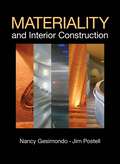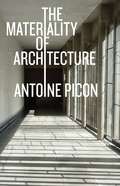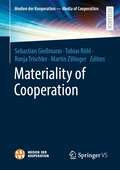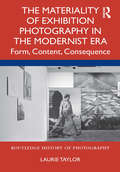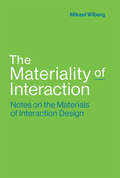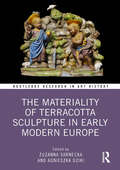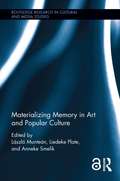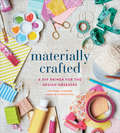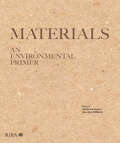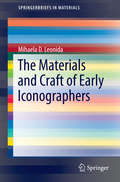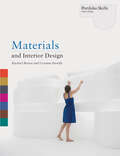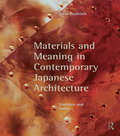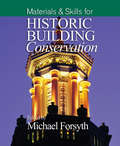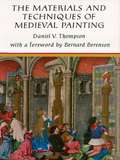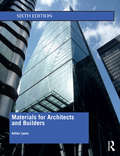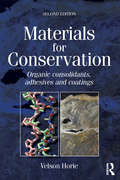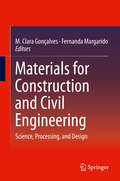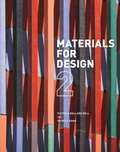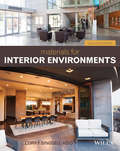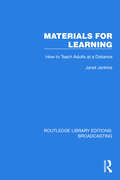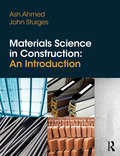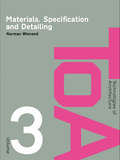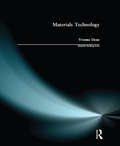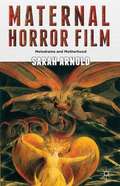- Table View
- List View
Materiality and Interior Construction
by Nancy Gesimondo Jim PostellA comprehensive reference of materials for interior designers and architects Choosing the right material for the right purpose is a critical-and often overlooked-aspect in the larger context of designing buildings and interior spaces. When specified and executed properly, materials support and enhance a project's overall theme, and infuse interior space with a solid foundation that balances visual poetry and functionality. Materiality and Interior Construction imparts essential knowledge on how materials contribute to the construction and fabrication of floors, partitions, ceilings, and millwork, with thorough coverage of the important characteristics and properties of building materials and finishes. Individual coverage of the key characteristics of each material explores the advantages and disadvantages of using specific materials and construction assemblies, while helping readers discover how to make every building element count. In addition, Materiality and Interior Construction: Is highly illustrated throughout to show material properties and building assemblies Supplies rankings and information on the "green" attributes of each material so that designers can make informed decisions for specifications Is organized by application for easy and quick access to information Includes a companion website, featuring an extensive online image bank of materials and assemblies Rather than a typical catalog of materials, Materiality and Interior Construction is efficiently organized so that the reader is guided directly to the options for the location or assembly they are considering. Reliable and easy to use, Materiality and Interior Construction is a one-stop, comprehensive reference for hundreds of commonly used materials and their integration as building components-and an invaluable resource that every interior designer or architect should add to their set of tools.
The Materiality of Architecture
by Antoine PiconA new paradigm combining architectural tradition with emerging technologies Digital tools have launched architecture into a dizzying new era, one in which wood, stone, metal, glass, and other traditional materials are augmented by pixels and code. In this ambitious exploration, an eminent thinker examines what, exactly, the building blocks of architecture have meant over the centuries and how technology may—or may not—be changing how we think about them. Antoine Picon argues that materiality is not only about matter and that the silence and inscrutability—the otherness—of raw materials work against humanity&’s need to live in a meaningful world. He describes how people define who they are, in part, through their specific physical experience of architectural materials and spaces. Indeed, Picon asserts, the entire paradox of the architectural discipline consists in its desire to render matter expressive to human beings. Through a retrospective review of canonical moments in Western European architecture, Picon offers an original perspective on the ways materiality has varied throughout centuries, demonstrating how experiences of the physical world have changed in relation to the evolution of human subjectivity. Ultimately, Picon concludes that computer-based design methods are not an abrupt departure from previous architectural traditions but rather a new way for architects to control material resources. The result reinforces the fundamentally humanistic nature of architectural endeavor with an increasing sense of design freedom and a release from material constraint in the digital era.
Materiality of Cooperation (Medien der Kooperation – Media of Cooperation)
by Sebastian Gießmann Tobias Röhl Ronja Trischler Martin ZillingerThe volume investigates the socio-material dimension and media practices of cooperation – before, during and beyond situations. Cooperation is understood as reciprocal interplay operating with or without consensus, in co-presence or absence of the involved actors in distributed situations. Artefacts, bodies, texts and infrastructures are the media that make cooperation possible. They enable and configure reciprocal accomplishments – and are themselves created through media practices in cooperative situations.
The Materiality of Exhibition Photography in the Modernist Era: Form, Content, Consequence (Routledge History of Photography)
by Laurie TaylorThis book challenges the status quo of the materiality of exhibited photographs, by considering examples from the early to mid-twentieth century, when photography’s place in the museum was not only continually questioned but also continually redefined. By taking this historical approach, Laurie Taylor demonstrates the ways in which materiality (as opposed to image) was used to privilege the exhibited photograph as either an artwork or as non-art information. Consequently, the exhibited photograph is revealed, like its vernacular cousins, to be a social object whose material form, far from being supplemental, is instead integral and essential to the generation of meaning. The book will be of interest to scholars working in art history, history of photography, theory of photography, curatorial studies and museum studies.
The Materiality of Interaction: Notes on the Materials of Interaction Design (The\mit Press Ser.)
by Mikael WibergA new approach to interaction design that moves beyond representation and metaphor to focus on the material manifestations of interaction.Smart watches, smart cars, the Internet of things, 3D printing: all signal a trend toward combining digital and analog materials in design. Interaction with these new hybrid forms is increasingly mediated through physical materials, and therefore interaction design is increasingly a material concern. In this book, Mikael Wiberg describes the shift in interaction design toward material interactions. He argues that the “material turn” in human-computer interaction has moved beyond a representation-driven paradigm, and he proposes “material-centered interaction design” as a new approach to interaction design and its materials. He calls for interaction design to abandon its narrow focus on what the computer can do and embrace a broader view of interaction design as a practice of imagining and designing interaction through material manifestations. A material-centered approach to interaction design enables a fundamental design method for working across digital, physical, and even immaterial materials in interaction design projects.Wiberg looks at the history of material configurations in computing and traces the shift from metaphors in the design of graphical user interfaces to materiality in tangible user interfaces. He examines interaction through a material lens; suggests a new method and foundation for interaction design that accepts the digital as a design material and focuses on interaction itself as the form being designed; considers design across substrates; introduces the idea of “interactive compositions”; and argues that the focus on materiality transcends any distinction between the physical and digital.
The Materiality of Terracotta Sculpture in Early Modern Europe (Routledge Research in Art History)
by Zuzanna Sarnecka Agnieszka DzikiThrough meticulously researched case studies, this book explores the materiality of terracotta sculpture in early modern Europe. Chapters present a broad geographical perspective showcasing examples of modelling, firing, painting, and gilding of clay in Portugal, Spain, Italy, Germany, and the Netherlands. The volume considers known artworks by celebrated artists, such as Luca della Robbia, Andrea del Verrocchio, Filipe Hodart, or Hans Reichle, in parallel with several lesser-studied terracotta sculptures and tin-glazed earthenware made by anonymous artisans. This book challenges arbitrary distinctions into the fine art and the applied arts, that obscured the image of artistic production in the early modern world. The centrality of clay in the creative processes of artists working with two- and three-dimensional artefacts comes to the fore. The role of terracotta figures in religious practices, as well as processes of material substitutions or mimesis, confirm the medium’s significance for European visual and material culture in general. This book will be of interest to scholars working in art history, Renaissance studies, and material culture.
Materializing Memory in Art and Popular Culture (Routledge Research in Cultural and Media Studies)
by Laszlo Muntean Liedeke Plate Anneke SmelikMemory matters. It matters because memory brings the past into the present, and opens it up to the future. But it also matters literally, because memory is mediated materially. Materiality is the stuff of memory. Meaningful objects that we love (or hate) function not only as aide-mémoire but are integral to memory. Drawing on previous scholarship on the interrelation of memory and materiality, this book applies recent theories of new materialism to explore the material dimension of memory in art and popular culture. The book’s underlying premise is twofold: on the one hand, memory is performed, mediated, and stored through the material world that surrounds us; on the other hand, inanimate objects and things also have agency on their own, which affects practices of memory, as well as forgetting. By accounting for the material world as a medium through which acts of remembering and forgetting take place, the chapters of this book offer new insights on such topics as the study of ruins, the exchange and circulation of souvenirs, digitization and the Internet of Things, fashion and technology, as well as the material dimensions of corporeality and traumatic re-enactment.
Materially Crafted: A DIY Primer for the Design-Obsessed
by Victoria Hudgins&“Perfect for anyone embracing their crafty side for the first time (or those who just want to keep developing their design chops)&” (HGTV). Design enthusiasts are bombarded with beautiful inspiration at every turn, but many lack the foundation necessary to recreate their dream projects. In Materially Crafted, Victoria Hudgins, creator of the popular design blog A Subtle Revelry, uncovers the best and least intimidating ways to work with the most popular crafting materials—from spray paint and concrete to thread, wax, and paper—and presents more than thirty easy projects to get everyone started. Peppered with Hudgins&’s tips for &“merrymaking the everyday&” (using simple DIY ideas to live life more joyfully) plus inspirational photos of projects created by other prominent bloggers, Materially Crafted is an indispensable guide for a new generation of design enthusiasts looking to DIY their own distinctive style. &“Her book focuses on materials and great ways (including 30 main projects) to transform them into something special.&” —Design*Sponge
Materials: An environmental primer
by Hattie Hartman Joe Jack WilliamsThe environmental impacts of construction are momentous. How can architects minimise these by making responsible material choices? Material choices have a global impact. The design and construction industry are responsible for 39% of all carbon emissions in the world. Despite the great desire among architects to address this, it can be difficult to compare materials directly, let alone understand the repercussions of selecting materials for use in different parts of a building or of sourcing them from across the world. Showcasing the latest thought leadership from subject experts across the industry, this primer sets out the various considerations and parameters for specifying a particular material. It empowers architects with the knowledge of which materials are available, how best to use them, and what their future holds as the industry continues to innovate. Each chapter will be devoted to a single material and will consider environmental impacts holistically, looking at health and biodiversity impacts, among other issues. Featuring: Chapters written by subject experts, including: Duncan Baker-Brown, Carol Costello, Graham Coult, Barbara Jones, Rowland Keable, Bruce Martin, Michael Stacey and Oliver Wilton. Mainstream and burgeoning materials, including: aluminium, bamboo, brick, concrete, cork, hemp, mycelium, plastics, steel, stone and timber. Diagrams, graphics and illustrated exemplars.
The Materials and Craft of Early Iconographers
by Mihaela D. LeonidaThis book describes in detail the materials and techniques used by medieval iconographers. It offers information about the natural sources, the raw materials, the tools and the technologies involved in preparing them. The book allows entry into the secretive world of very knowledgeable and skilled artisans, about which very little is known. Topics covered include raw materials, pigments, binders, solvents, adhesives, inks and varnishes. Special chapters will be dedicated to the fresco technique as practiced by the early iconographers, grinding, painting on glass and the training/apprenticeship of these craftsmen.
Materials and Interior Design
by Rachael BrownThe choice of materials is critical to the success of an interior. This book examines every aspect of the the use of materials in interior design, from initial concept and selection to visual representation and practical application. Following a brief introduction, the first five sections offer historical context and detailed guidance on selection, application, representation, communication, and sources, while the sixth and final section features case studies by international interior designers. The book includes useful step-by-step sequences, information on properties and sustainability, and a list of resources, online archives and sample libraries. It is an invaluable practical and inspirational guide for interior design students.
Materials and Interior Design (Portfolio Skills)
by Lorraine Farrelly Rachael BrownThe choice of materials is critical to the success of an interior. This book examines every aspect of the the use of materials in interior design, from initial concept and selection to visual representation and practical application. Following a brief introduction, the first five sections offer historical context and detailed guidance on selection, application, representation, communication, and sources, while the sixth and final section features case studies by international interior designers. The book includes useful step-by-step sequences, information on properties and sustainability, and a list of resources, online archives and sample libraries. It is an invaluable practical and inspirational guide for interior design students.
Materials and Meaning in Contemporary Japanese Architecture: Tradition and Today
by Dana BuntrockIn this beautiful and perceptive book, Dana Buntrock examines, for the first time, how tradition is incorporated into contemporary Japanese architecture. Looking at the work of five architects – Fumihiko Maki, Terunobu Fujimori, Ryoji Suzuki, Kengo Kuma, and Jun Aoki – Buntrock reveals the aims influencing many wonderful works barely known in the West; the sensual side of Japanese architecture borne out of approaches often less concerned with professionalism than with people and place. The buildings described in this book illustrate an architecture that embraces uniqueness, expressing unusual stories in the rough outlines of rammed earth and rust, and demonstrating new paths opening up for architectural practice today. For some, these examples will offer new insight into expressions of tradition in Japanese architecture; for others, this book offers inspiration for their own efforts to assert the unique heritage of other regions around the world. Compelling, insightful and groundbreaking, this book is essential for everyone studying Japanese architecture and anyone trying to invoke narrative and tradition in contemporary design.
Materials and Skills for Historic Building Conservation (Historic Building Conservation)
by Michael ForsythThis book is the third in a series of volumes that combine conservation philosophy in the built environment with knowledge of traditional materials, and structural and constructional conservation techniques and technology: Understanding Historic Building Conservation Structures & Construction in Historic Building Conservation Materials & Skills for Historic Building Conservation The series aims to introduce each aspect of conservation and to provide concise, basic and up-to-date knowledge for architects, surveyors and engineers as well as for commissioning client bodies, managers and advisors. In each book, Michael Forsyth draws together chapters by leading architects, structural engineers and related professionals to reflect the interdisciplinary nature of conservation work. The books are structured to be of direct practical application, taking the reader through the process of historic building conservation and emphasising throughout the integrative teamwork involved. The present volume - Materials & Skills for Historic Building Conservation – describes the characteristics and process of decay of traditional materials which inform the selection of appropriate repair techniques. It provides essential information on the properties of the principal traditional external building materials. Their availability, sourcing and environmental impact is covered, as well as the causes of erosion and decay, and the skills required for their application on conservation projects. It covers the main most commonly used materials and conservation techniques including stone, brickwork, lime products, concrete, iron and steel, timber, wattle and daub, and glass, Thirteen chapters written by the experts present today's key issues in materials and skills for historic building conservation: Gus Astley, Patrick Baty, Charley Brentnall, Michael Bussell, Michael Forsyth, Tony Graham, Chris Harris, David McLaughlin, Brian Ridout, Mike Stock, Geoff Wallis, Ian Williams, Rory Young
The Materials and Techniques of Medieval Painting (Dover Art Instruction)
by Daniel V. ThompsonMedieval painters built up a tremendous range of technical resources for obtaining brilliance and permanence. In this volume, an internationally known authority on medieval paint technology describes these often jealously guarded recipes, lists of materials, and processes. Based upon years of study of medieval manuscripts and enlarged by laboratory analysis of medieval paintings, this book discusses carriers and grounds, binding media, pigments, coloring materials, and metals used in painting. It describes the surfaces that the medieval artist painted upon, detailing their preparation. It analyzes binding media, discussing relative merits of glair versus gums, oil glazes, and other matters. It tells how the masters obtained their colors, how they processed them, and how they applied them. It tells how metals were prepared for use in painting, how gold powders and leaf were laid on, and dozens of other techniques. Simply written, easy to read, this book will be invaluable to art historians, students of medieval painting and civilization, and historians of culture. Although it contains few fully developed recipes, it will interest any practicing artist with its discussion of methods of brightening colors and assuring permanence. "A rich feast," The Times (London). "Enables the connoisseur, artist, and collector to obtain the distilled essence of Thompson's researches in an easily read and simple form," Nature (London). "A mine of technical information for the artist," Saturday Review of Literature.
Materials for Architects and Builders
by Arthur LyonsMaterials for Architects and Builders provides a clear and concise introduction to the broad range of materials used within the construction industry and covers the essential details of their manufacture, key physical properties, specification and uses. Understanding the basics of materials is a crucial part of undergraduate and diploma construction or architecture-related courses, and this established textbook helps the reader to do just that with the help of colour photographs and clear diagrams throughout. This new 6th edition has been completely revised and updated to include the latest developments in materials research, new images, appropriate technologies and relevant legislation. The ecological effects of building construction and lifetime use remain an important focus, and this new edition includes a wide range of energy saving building components.
Materials for Conservation
by C V HorieMaterials in Conservation is the definitive introduction to the properties of materials used in conservation. The continual struggle of conservators to ameliorate the deterioration of objects has led to increasing use of synthetic polymers. These materials are part of the sophisticated technology that has been developed to augment and often replace traditional materials and methods. Conservators therefore have a wider range of techniques available. However, they must be able to appreciate the potentials and pitfalls of any proposed technique. The first section explains physical and chemical properties which are important in the conservation process, i.e. application, ageing, reversal. The topics covered include molecular weight, glass transition temperature, solubility and solvents, polymerisation and degradation reactions. The second section provides a detailed consideration of the individual materials, current and obsolete, used in conservation, drawing out the factors relevant to their effects on objects. The conservation uses of each material are summarised and referenced to allow further study. In five appendices, the properties of the polymers, solvents and their interactions are tabulated, with a list of suppliers and conversion table of physical units. IUPAC and SI nomenclature is used throughout the book. In this second edition, this classic text is revised and updated to include modern materials such as cyclododecane, and current ideas on adhesion, consolidation and reversibility, making Materials in Conservation the definitive source of vital information in the field. This handy reference book should be on the bench of every conservator and available wherever objects, from steam engines to dried plants, are preserved.
Materials for Construction and Civil Engineering
by M. Clara Gonçalves Fernanda MargaridoThis expansive volume presents the essential topics related to construction materials composition and their practical application in structures and civil installations. The book's diverse slate of expert authors assemble invaluable case examples and performance data on the most important groups of materials used in construction, highlighting aspects such as nomenclature, the properties, the manufacturing processes, the selection criteria, the products/applications, the life cycle and recyclability, and the normalization. Civil Engineering Materials: Science, Processing, and Design is ideal for practicing architects; civil, construction, and structural engineers, and serves as a comprehensive reference for students of these disciplines. This book also: · Provides a substantial and detailed overview of traditional materials used in structures and civil infrastructure · Discusses properties of natural and synthetic materials in construction and materials' manufacturing processes · Addresses topics important to professionals working with structural materials, such as corrosion, nanomaterials, materials life cycle, not often covered outside of journal literature · Diverse author team presents expect perspective from civil engineering, construction, and architecture · Features a detailed glossary of terms and over 400 illustrations
Materials for Design 2
by Victoria Ballard Bell Patrick RandAs architecture and design programs throughout the world break out of the classroom and adopt the holistic methods of design/build programs, the need for a textbook that bridges the gap between construction materials and design sensibility is sorely needed. <p><p>In Materials for Design 2, authors Victoria Ballard Bell and Patrick Rand revisit the format of their award-winning first volume and present sixty new case studies of materials put to imaginative use by today's brightest architects. Bell and Rand introduce each material type—glass, concrete, wood, metal, plastic, and stone—with new text describing its history and significance. Accessible case studies highlight recent advances in design and construction around the world—from a wooden church in Finland and huts in Thailand to a bank encased in a glass cube in Denmark. <p><p>In a materials landscape that constantly changes to meet the demands of contemporary designers, Materials for Design 2 is an up-to-date guide to the best and most exciting materials at their disposal.
Materials for Interior Environments
by Corky BinggeliOrganized by types of materials and applications, this guide helps designers successfully address material evaluation and selection of interior components. Engagingly written, highly detailed, and helpfully illustrated with more than 550 color illustrations, Materials for Interior Environments is a comprehensive guide to everything a designer needs to know about the materials available for interiors--from aesthetic qualities to manufacturing and fabrication, applications, installation and maintenance, and specifications for materials used in commercial and residential applications.
Materials for Learning: How to Teach Adults at a Distance (Routledge Library Editions: Broadcasting #26)
by Janet JenkinsMaterials for Learning (1981) examines the ability of books and broadcasts to change lives. The combination of print, radio, television and group meetings – distance teaching – can transform education in developing countries. Effective distance teaching requires effective teaching materials, and up to now there has been a lack of guidance about how to produce such materials and how to do so for different cultures. Materials for Learning aims to supply this need by suggesting guidelines for action and, where evidence is mixed or lacking, defining questions that still require answers. It is a practical book aimed at people actively involved in nonformal education and will be particularly useful for the developing world educators. The book looks first at how distance teaching can help with educational problems, considers how adults learn, and surveys problems of language and culture. It then considers the planning of distance teaching and looks in detail at the use of different media. There were also chapters on teaching numeracy and science at a distance, and a discussion of the kind of support that can be provided for people studying at a distance.
Materials Science In Construction: An Introduction
by Arshad Ahmed John SturgesMaterials Science in Construction explains the science behind the properties and behaviour of construction's most fundamental materials (metals, cement and concrete, polymers, timber, bricks and blocks, glass and plaster). In particular, the critical factors affecting in situ materials are examined, such as deterioration and the behaviour and durability of materials under performance. An accessible, easy-to-follow approach makes this book ideal for all diploma and undergraduate students on construction-related courses taking a module in construction materials.
Materials, Specification and Detailing: Foundations of Building Design (Technologies of Architecture #Vol. 3)
by Norman WienandContinuing in the holistic philosophy of the Technologies of Architecture series, this volume examines the various layers of knowledge, skills and mechanisms that make up the many approaches to the essential function of technical design in the creation of successful buildings. Well-illustrated with case studies, the author draws on his extensive experience in architectural education to provide a detailed description of the development process, acknowledging traditional solutions whilst also encouraging designers to consider innovative alternatives. Attention is paid to materials choices, detail design and specification writing. Students of architectural technology in particular, but also of architecture, building surveying and construction will find this syllabus-relevant title an invaluable asset in embracing their environmental responsibilities as designers and actively participating in the development of technical design language.
Materials Technology (Mitchell's Building Series)
by Yvonne DeanMaterials Technology clearly identifies materials and technology as the fundamental generators of buildings and examines how they determine the structure, overall form and quality. It examines the issues that determine the choice of materials, and argues that the decision-making of architects, engineers and designers should take account of the environmental impact of sourcing the basic materials, and of the energy implications of their processing and use in manufacturing.Materials Technology is an essential resource for Materials Technology units in building, architecture and surveying degree and postgraduate courses; and students of BTEC HNC/D building and surveying. It will also be a useful reference tool for Advanced GNVQ Construction and the Built Environment courses and Built Environment NVQs at levels 3 and 4.
Maternal Horror Film
by Sarah ArnoldMaternal Horror Film: Melodrama and Motherhood examines the function of the mother figure in horror film. Using psychoanalytic film theory as well as comparisons with the melodrama film, Arnold investigates the polarized images of monstrous and sacrificing mother.
